- The value of a game-like experiences used for learning is becoming
 more evident with benefits such as improved: performance; decision making; leadership skills.
more evident with benefits such as improved: performance; decision making; leadership skills.
- Games can be designed to help lead the player into discovering skills and solutions without giving the player the answers. In addition, getting a great game experience doesn’t have to be hard.
- Players gain a sense of accomplishment each time they finish a level, which does not seem much like “training.”
- Employees clearly benefit from the knowledge and skills they can learn in their employer’s courses.
- Games can make training more enjoyable. Because they are interactive, games can keep the interest of the players throughout the program.
- Games are an effective performance improvement methodology for almost all audiences—even senior executives — especially senior executives. Your audience may be more receptive to using games for training than you think.
- Today’s Role-Play Games and Alternate Reality Games are not the single-user joystick games of years past. They require collaboration, team building, as well as smart use of resources, strategy, and follow-through. The most successful Role-Play Games players also tend to be great leaders and team-builders.
- Competition: Every business is a competition. Many internal functions are a competition, too; competition for attention, scarce resources, funding, etc. Games are inherently competitive. Learning how to be a better competitor will also make you a better business person.
- Engagement: I can’t learn anything if I’m not paying attention. Why teach me an abstract skill when you can get me to engage in the actual behavior? Games get me involved, give me a goal, and help me understand what I have to do to hit that goal. All fairly painlessly—in fact, I might not even realize that I’m supposed to be learning.
- Social learning: Whether we’re playing our game in a real-life room or playing online in a virtual space, we’re still working in a social environment. That means that we can create our own experience (within the rules of the game, of course), and the experience changes based on the people present. We can share our knowledge, experiences, assumptions, and learn from and teach each other. We may be playing a game, but what we’re learning from each other is very real.
- Informal Learning: Game environments create wonderful opportunities for informal learning. As a team of people driving towards a goal, we inevitably share all kinds of knowledge. All the notebooks in the world won’t drive knowledge like an experienced colleague sharing a great story.
- Collaboration (or lack thereof): Great games for learning use goal-based scenarios where teams of people need to collaborate to achieve success. This is a great opportunity for participants to understand what each role brings to the table, how collaboration drives a better outcome. Learning this kind of behavior in a game is “sticky;” it will stay with you long after the game is over.
These tips were pulled from a number of our blog articles on using games in learning. For additional information click on the following links:
- The Gamification of Learning and Instruction Fieldbook
- The Chocofication of Learning
- How Games Improve Performance, Part 1
- How Games Improve Performance, Part 2
- Learning from Game Developers

Amanda Cushman Holm is the
Sales and Marketing Specialist at
Performance Development Group

 Zork, which created a very compelling and immersive world using only text. I remember thinking, if we can become so involved in fictional worlds like this, what would happen if we became immersed in real-life scenarios the same way? It would be a lot like doing it for real, except we'd be in a nice safe environment where we could try new behaviors and there would be little penalty for failing.
Zork, which created a very compelling and immersive world using only text. I remember thinking, if we can become so involved in fictional worlds like this, what would happen if we became immersed in real-life scenarios the same way? It would be a lot like doing it for real, except we'd be in a nice safe environment where we could try new behaviors and there would be little penalty for failing.



 o you want your learners to collaborate? To demonstrate leadership skills? To drive towards a goal? To evaluate and analyze situations before committing to a decision? To value the perspectives of others? To improve performance?
o you want your learners to collaborate? To demonstrate leadership skills? To drive towards a goal? To evaluate and analyze situations before committing to a decision? To value the perspectives of others? To improve performance? nesses about using games to improve performance way back in 1985. Back then, I was working mostly with mid-level and senior mangers, so talking about games required hushed tones and euphemisms. After all, busy important managers couldn’t spend time playing games. They had big, big decisions to make. And so what if the game was designed to help them be even more effective in making those big, big decisions? This was serious business. They weren’t games; they were “experiences,” or “competitions,” or “challenges.” Or maybe you just didn’t talk about it at all.
nesses about using games to improve performance way back in 1985. Back then, I was working mostly with mid-level and senior mangers, so talking about games required hushed tones and euphemisms. After all, busy important managers couldn’t spend time playing games. They had big, big decisions to make. And so what if the game was designed to help them be even more effective in making those big, big decisions? This was serious business. They weren’t games; they were “experiences,” or “competitions,” or “challenges.” Or maybe you just didn’t talk about it at all. Recently, I read an article on
Recently, I read an article on 
